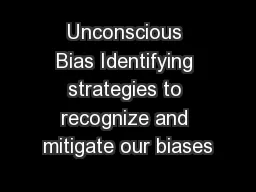

Learning Objectives Recognize that bias is human and that it impacts all parts of all of our lives Identify the negative consequences of bias are Develop strategies to become more aware of and mitigate our biases ID: 660520
Download Presentation The PPT/PDF document "Unconscious Bias Identifying strategies ..." is the property of its rightful owner. Permission is granted to download and print the materials on this web site for personal, non-commercial use only, and to display it on your personal computer provided you do not modify the materials and that you retain all copyright notices contained in the materials. By downloading content from our website, you accept the terms of this agreement.
Slide1
Unconscious Bias
Identifying strategies to recognize and mitigate our biasesSlide2
Learning Objectives
Recognize that bias is human and that it impacts all parts of all of our lives
Identify the negative consequences of bias are
Develop strategies to become more aware of and mitigate our biases
Identify tools to effectively recognize and acknowledge when we observe instances of unconscious bias with our learners and colleaguesSlide3
What are your associations with “bias” and “unconscious bias”? Slide4
F
eelings, Judgments,
and
R
eactionsSlide5Slide6Slide7Slide8Slide9Slide10Slide11
Gender
Skin tone
Setting
Body type
Body posture
Clothing
Facial expression
Ethnicity
Age
What patterns
did
you notice?Slide12Slide13
John
Fetterman
Mayor of Braddock, PA (a suburb of Pittsburgh) – the tattoo on his arm is the zip code
!
Has a Master’s degree in Public Policy from
Harvard
Served in the
AmeriCorps
Received international media attention for the economic revitalization programming he started in his communitySlide14
Pratibha
Patil
Economist
Attorney
First
female president of India, 2007-2012Slide15
Philip
Markoff
Boston
University m
edical student (2009)
'Craigslist
Killer
'Slide16
Byron Rushing
MA House of Representatives, 9
th
Suffolk district (South End), since 1982
Serves as the Majority
Whip
Priorities include environmental justice and health care.Slide17
Tamika Cross, MD
Chief
OB/GYN Resident at
the Harris Health Lyndon B. Johnson
Hospital
, University of Texas Health Science Center at Houston
Delta Air Lines staff didn't believe she
was
a doctor during
an in-flight
medical emergency Slide18Slide19Slide20
C
ouple applying
for a marriage license in
Seattle, WA
.Slide21
Thoughts?
Reactions?
What
did you notice?
Have you
observed or experienced
examples y
our
own life?Slide22
Reactions?
Have you seen examples of unconscious bias in:
Your own life?
Work in groups of 2 or 3Slide23
What is bias?
A tendency or inclination that results in judgment without
question
A shortcut to interact with our world
An automatic responseSlide24
Mental associations
without:
Awareness
Intention
Control
These often conflict with our conscious
attitudes, behaviors, and intentions.
What is Unconscious Bias?Slide25
There are many kinds of biases, and as humans, we all have them.
Race/ethnicity
Sex
Gender identity
National origin/geography/rurality
Disability status
Education
Physical appearance/height/weight
Personality
Age
Others?Slide26
Why is bias important to address in the academic health sciences environment?Slide27
Weight
A study involving 2284 MDs found
that
doctors
show a strong implicit bias against overweight people
.
Men’s bias was stronger than
women’s.
B
ias
was strongest among those
MDs
who were the thinnest.
Sabin JA, et al
. PLoS One. 2012;7(11):e48448Slide28
The Effect of Race and Sex on Physicians' Recommendations for Cardiac Catheterization
“Men
and whites were significantly more likely to be referred than women and blacks
.”
Schulman K, et
. al, N
Engl
J Med. 1999 Feb 25;340(8):618-26Slide29
Believed that compared to whites, blacks:
Age more slowly
Have less sensitive nerve endings
H
ave smaller brains
Have thicker skin
Have stronger immune systems
Survey of the general public (online, n=92), medical students (first through third year, n=194), and residents (n=28)Slide30Slide31
‡, P < .001
Ginther
,
DK,
Science
,
2011:333;1015-1019
Black scientist applicants
to
NIH are
10% points
less likely than whites to be awarded NIH research
funding
Race,
Ethnicity, and NIH Research AwardsSlide32
Are Emily and Greg More Employable than Lakisha and Jamal? A Field Experiment on Labor Market Discrimination
50% difference in call
back rate for job
interview based on names only
“
W
hite
” sounding name
- 9.7%
“
B
lack
” sounding name
- 6.5%
Bertrand, M., & Mullainathan, S. American Economic Review 2004, v94(4,Sep), 991-1013Slide33
Scientific community. U.S. study shows unconscious gender bias in academic
science
Yale University asked 127 professors to judge identical resumes from a female and male applicant
Significantly more likely to (p< 0.05)
Hire the man
Pay him higher salary
See him as more worthy of mentoring
Bias was equally strong among women & men
Bias did not vary by age, race, or discipline
Mervis
, J.
Science
2012; 337(6102);
1592-1592. Slide34
Thoughts?Slide35
6 Ways to Mitigate Your Biases
Recognize and accept that you have
bias
Develop the capacity to use a flashlight on
yourself
Practice “Constructive
Uncertainty”
Explore awkwardness, and
discomfort
Engage with people you consider “others” and expose yourself to positive role models in that
group
Get
feedbackSlide36
The Unfinished WorkSlide37
Freedom is the pause between stimulus and response.
- Rollo MaySlide38
Take a P.A.U.S.E.
A quick way to check your reaction.Slide39
Examples of unconscious bias from your own lives
In groups of 3,
describe a situation in which you observed unconscious bias in the workplace at play
.
What are the challenges?
What strategies can you employ to address it?
Suggested per person: 1-2
minutes to describe
situation; 3 minutes
to peer coach
&
provide feedbackSlide40
Based on what we have discussed today, identify concrete action-steps:
How will you use this information to improve your relationship with a colleague?
Identify an important decision-making point you have coming up, and strategize how you can mitigate the impact of bias in this decision.
Come up with an idea for recognizing, navigating, and/or mitigating biases in your team, department or organization.
Journal for 5 minutes
Your CommitmentSlide41
Thank you
Dr. Yvette Cozier, BU School of Public Health (
yvettec@bu.edu
)
Dr. Larry Dunham, BU Goldman School of Dental Medicine (
lgdunham@bu.edu
)